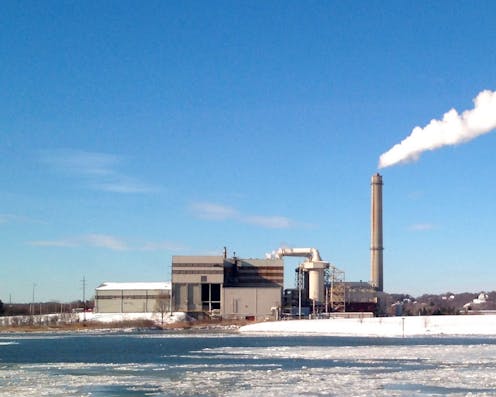Is burning trash a good way to handle it? Waste incineration in 5 charts
Every year the US burns more than 34 million tons of garbage in incinerators. These plants are major pollution sources, and most are clustered in disadvantaged communities.

Burning trash has a long history in the United States, and municipal solid waste incinerators have sparked resistance in many places. As an environmental justice scholar who works directly with low-income and communities of color, I see incineration as a poor waste management option.
Although these plants generate electricity from the heat created by burning trash, their primary purpose is waste disposal. Emissions from burning waste worsen environmental inequalities, create financial risks for host communities and reduce incentives to adopt more sustainable waste practices.
I recently co-authored a report that describes signs of decline in the U.S. waste incineration industry due to many factors. They include a volatile revenue model, aging plants, high operation and maintenance costs, and growing public interest in reducing waste, promoting environmental justice and combating climate change.
Nonetheless, 72 incinerators are still operating today in the U.S. Most of them – 58, or 80% – are sited in environmental justice communities, which we defined as areas where more than 25% of residents are low-income, people of color or both. Incinerators worsen cumulative impacts from multiple pollution sources on these overburdened neighborhoods.
Environmental justice flashpoints
Waste incinerators are heavily concentrated in northeast states and Florida – areas with high population densities and limited landfill space. Some of these states also provide favorable economic incentives, such as allowing incinerators to earn renewable energy credits for generating electricity.
In the past year environmental justice advocates have successfully shut down incinerators in Detroit, Michigan, and Commerce, California. The Detroit incinerator was built in the 1980s and received more than US$1 billion in public investment borne by local taxpayers. Groups such as Breathe Free Detroit and Zero Waste Detroit rallied residents to oppose the public financing and health burdens that the facility imposed on surrounding environmental justice communities. The plant closed in March 2019.
The California plant closed in June 2018 after a yearlong campaign by two community-based organizations, East Yard Communities for Environmental Justice and Valley Improvement Projects, to prevent incineration from qualifying for state renewable energy subsidies. The facility ultimately closed when a 30-year power purchase agreement with the local utility expired, leaving it without a sufficient revenue stream.
Aging facilities
Incineration plants’ average life expectancy is 30 years. Three-quarters of operating waste incinerators in the United States are at least 25 years old.
These facilities’ revenues come primarily from tipping fees that waste haulers pay to dump trash, and secondarily from generating electricity. These revenue streams are volatile and can undermine the industry’s financial stability. At least 31 incinerators have closed since 2000 due to issues such as insufficient revenue or inability to afford required upgrades.
Operations and maintenance costs typically increase as plants age and their performance decreases. Upgrades, such as installing new pollution control equipment, can cost tens of millions of dollars, and sometimes more than US$100 million.
These large capital expenditures represent risks for host communities, which often provide public financing through bonds or tax increases. Such measures are risky because the waste service and energy contracts that generate revenue are increasingly shorter term and vulnerable to fluctuating market and regulatory conditions. As plants age, their environmental performance may also degrade over time, posing increasing risks to the environment and public health.
What incinerators burn
The composition of municipal solid waste has changed over the past 50 years. Synthetic materials such as plastics have increased, while biogenic, compostable materials such as paper and yard trimmings have decreased.
Plastics are particularly problematic for waste handling because they are petroleum-based, nonbiogenic materials. They are difficult to decompose and release harmful pollutants such as dioxins and heavy metals when they are incinerated.
Waste management trends
Today, thanks to the evolution of waste handling options, a majority of the materials in municipal solid waste can be composted or recycled. This reduces impacts on the environment, including air, soil and water contamination and greenhouse gas emissions. As cities like New York and San Francisco adopt zero-waste policies that create incentives for diverting waste from landfills or incinerators, burning trash will increasingly become obsolete.
Many U.S. cities and states are adopting aggressive climate change and sustainability goals. Waste reduction and diversion will play a critical part in meeting these targets. The public is increasingly demanding more upstream solutions in the form of extended producer responsibility bills, plastic bans and less-toxic product redesign. There is also a growing movement for less-consumptive lifestyles that favors zero-waste goals.
Heavy polluters
Incinerators release many air pollutants, including nitrogen oxides, sulfur dioxides, particulate matter, lead, mercury, dioxins and furans. These substances are known to have serious public health effects, from increased cancer risk to respiratory illness, cardiac disease and reproductive, developmental and neurological problems. According to recent figures from the waste industry, incinerator plants emit more sulfur dioxide, nitrogen oxides and carbon dioxide per unit of electricity generated than power plants burning natural gas.
Research on direct health impacts of waste incineration in the United States is limited, but a handful of studies from Asia and Europe, where waste incinerators are prevalent, offer some insights. For example, a 2013 study in Italy analyzed the occurrence of miscarriages in women aged 15-49 years residing near seven incinerators in northern Italy’s Emilia-Romagna region, and found that increased particulate emissions from the incinerators was associated with an increased risk of miscarriage.
A single incinerator may burn anywhere from a few hundred tons to several thousand tons of waste per day. Smaller incinerators typically have lower absolute emissions but can emit more hazardous pollutants for each ton of waste they burn. Plant emissions also can vary widely based on the heterogeneous composition of municipal waste, the age and type of emissions control equipment, and how well the plant is operated and maintained over time.
Ana Baptista received funding from the Global Alliance for Incinerator Alternatives (GAIA) which received a grant from the JPB Foundation for the preparation of the report "U.S. Municipal Solid Waste Incinerators: An Industry in Decline". She is affiliated with GAIA, the New Jersey Environmental Justice Alliance and the Ironbound Community Corporation.
Read These Next
From record warming to rusting rivers, 2025 Arctic Report Card shows a region transforming faster th
The 20th anniversary of the annual report tracks how sea ice, snow cover and many other vital signs…
The next frontier in space is closer than you think – welcome to the world of very low Earth orbit s
The closer to Earth a satellite flies, the clearer a picture it can take of the surface. But low-flying…
Epstein’s victims deserve more attention than his ‘client list’
Powerful men connected to Jeffrey Epstein are named, dissected and speculated about. The survivors,…






